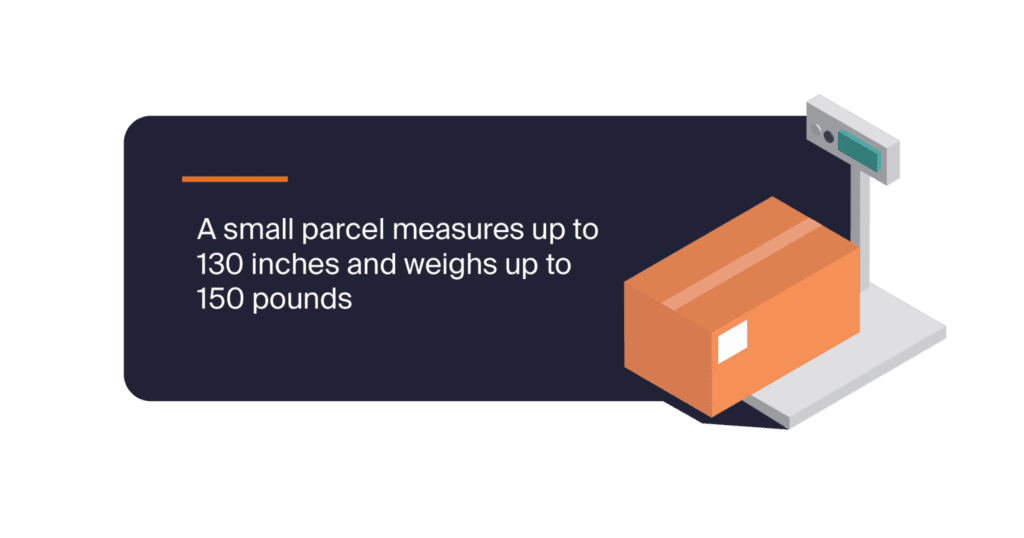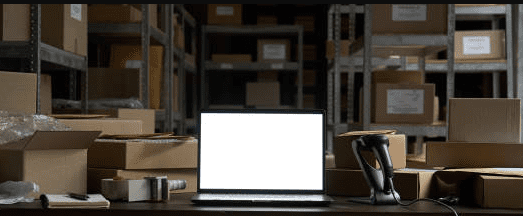In today’s anything, anytime world, delivery speed, and cost have become a make-or-break part of the business. Thanks to Amazon Prime, shoppers expect inexpensive 1-day and even same-day nationwide delivery from all stores, regardless of size. Consumer data also shows merchants that prioritize fast shipping have a distinct advantage over rivals.
But how can fast-growing brands deliver on these high expectations without hurting your profit margins?
While other areas of the business, such as working capital optimization and return on advertising spend, traditionally receive more attention, reducing delivery costs goes a long way toward increasing profitability.
Below, we’ll explore small parcel shipping strategies extensively, examining the factors, approaches, and service options to consider for quick, cost-effective delivery.
What Is Small Parcel Shipping?
Small parcel shipments, also referred to as light freight or parcel package delivery, usually weigh less than 150 pounds, can be lifted without assistance, and are shipped in businesses’ own packaging or carrier-supplied boxes. Typically, carriers such as UPS or courier services in local areas handle small parcel shipping.
Small parcel shipping usually has the following characteristics:
- Under 150 pounds.
- Low dimensional weight (DIM weight).
- Delivery trucks/vans aren’t longer than 28 feet.
- Delivery trucks/vans can hold 50–100 parcels.
- Delivery trucks/vans make multiple stops during the day at customers’ doors.
How Big Is a Small Parcel?

Small parcel size varies by carrier, as each has its stand-out standards.
For instance, UPS defines a small package as one with a combined length and girth (distance around the thickest part) of up to 130 inches and a maximum weight of 150 pounds. This allows for flexibility in shipping larger items within the small parcel category.
With DHL, however, a small parcel is much lower, at a maximum weight of 66 pounds. Always ensure that you check the specific guidelines of your chosen carrier.
Flexible rules for what counts as a small parcel help the shipping industry serve many different needs, which has helped it grow.
The Small Parcel Shipping Process
Make your small parcel shipping faster and more reliable by simplifying the process.
Here’s the process:
- Package Preparation: The sender manually packages and labels the parcel, meticulously organizing things like shipping information and special packaging needs.
- Carrier Pickup or Drop-Off: The package is handed over to the chosen carrier through pickup or drop-off at their location.
- Sorting and Loading: The carrier sorts the parcels, adds additional packaging and labeling if necessary, and loads them onto transportation like trucks or planes.
- Transit and Tracking: The package moves through the carrier’s network and is tracked via label scans, keeping both sender and recipient updated.
- Final Mile Delivery: The carrier delivers the parcel to the recipient’s address, with tracking to ensure successful delivery.
What Is Freight Shipping?
Generally reserved for larger shipments, freight shipping is much more complex compared to small parcel shipping, requiring more management. Freight shipping is packaged on pallets or in sturdy cargo containers and moved long distances by multiple modes of transportation like rail, ship, airplane, and truck.
The complexity of freight includes evaluating freight consolidation, transloading, cross-docking, and other strategies to reduce the cost of getting goods to customers. Further, with freight shipping, logistics managers must consider whether to utilize full truckload (FTL) or less-than-truckload (LTL) shipments to reach warehouses or retailers.
All of this deserves a full post of its own, beyond our scope here. We’ve dedicated this freight logistics guide to provide you with detailed guidance on the freight shipping process.
What Transit Modes Are Used in Freight Shipping?

Many modes of transportation are used in freight shipping, and freight is moved across every link of the supply chain, from importing to the final mile:
Ocean:
- It’s ideal for shipping bulky and large quantities of product, especially for international transit.
- It’s much less expensive than air.
Air:
- Goods arrive at the end of their journey in the shortest amount of time, which is why air is the most expensive shipping option.
Ground:
- Ground shipping is an inexpensive way to transport wares across the country.
- It comes in two forms: Full Truck Load (FTL) and Less-than Truck Load (LTL.)
Here are the key differences:
Full Truck Load (FTL)
- With FTL, a company designates an entire truck for the shipment.
- FTL works well for companies transporting large volumes, high-value products, and cases where the delivery requires tracking or has to be scheduled for dropoff at a specific time.
Less-than Truck Load (LTL)
- In LTL, packages are combined with other companies’ cargo traveling along the same route, so the cost of transportation is shared.
- LTL is a more cost-efficient option than FTL for smaller loads.
- However, LTL takes longer to arrive than FTL due to multiple stops and repacking requirements.
Freight shipping employs various transit modes, including ocean, air, rail, and over the road (OTR). These modes offer cost-effective options for transporting goods internationally and domestically, catering to both large volumes and smaller shipments.
Small Parcel Shipping Vs Freight

Both shipping models have pros and cons based on your needs. Here are the key differences:
Size Requirements
- Small parcel shipping typically has stricter size and weight limits compared to the flexibility of freight shipping, which can include a large consignment of small parcels.
- Small parcel shipping is well-suited for lower-volume and individual orders, while freight shipping is more economical for larger-volume and bulk orders.
End Destination
- Not all destinations, such as a private residence or a small storefront, are suitable for receiving a freight shipment. Small parcel shipping is a smarter option for such destinations.
Cost-Effectiveness
- Small parcel shipping rates generally come with a lower cost per pound. However, you’re less likely to have this advantage with larger items.
- Small parcel shipping price is based on the package weight, dimensions, and distance, whereas freight shipping rates are determined by weight, freight class, and mode of transport.
Delivery Speed
- Small parcel shipping offers more options for faster shipping — same day, 1–2 days, etc. Freight usually takes longer due to consolidation and routing.
- Unlike small parcel delivery, the freight cargo sizes and quantities are far too large to stack in the back of a UPS truck from the point of origin to the end destination.
General Processes and Requirements
If you understand the difference between small parcel shipping and freight shipping, you’ll make informed decisions, and save money on delivery solutions for your business.
- Small Parcel Shipping: Requires detailed manual work for individual packaging and labeling.
- Freight Shipping: Utilizes equipment like forklifts for efficiency but may not suit delicate items needing special care.
- Tracking: FTL freight shipments usually have tracking, but LTL, rail, and ocean typically don’t.
When Should eCommerce Merchants Use Small Parcel Shipping?

Small parcel shipping is an economical option for merchants sending a few smaller, lightweight packages to several individual locations. It works best for residential and small-to-medium-sized retail businesses that handle fulfillment in-house and aren’t moving enough volume or selling larger items to make freight a more cost-effective option.
For instance, an online direct-to-consumer T-shirt store should rely on small parcel delivery to send 4 packages from Atlanta to Philadelphia the next day to consumers who have a higher expectation for orders to arrive quickly and on time. However, if the same shop needed to mail 20 large boxes of T-shirts weighing 330 pounds from Atlanta to Philadelphia to a wholesale partner within 1 week, LTL is the better option.
What Type of Small Parcel Shipping Company Is Best for Your Business?
Now that you know how to handle your small parcel shipping best, let’s help you decide who to outsource it to.
Here are the 4 main categories of small parcel shipping companies:
Asset-Based Carriers
Asset-based carriers own their transportation facilities and provide end-to-end shipping solutions. Full control over their fleet allows for great reliability and consistency in delivery times.
Their services include pickup, sorting, loading, fulfillment warehousing, and delivery.
However, compared to other options, this often comes at higher operating costs and limited flexibility in areas not covered by the carrier.
Consolidators
Consolidators aggregate small shipments from multiple businesses into larger, more cost-effective batches. They leverage economies of scale to negotiate lower shipping rates with carriers.
However, there’s potential for delays or disruptions if the consolidation process is not managed effectively. To boot, users have limited control over individual shipments once handed over to carriers, which may impact visibility and tracking capabilities.
Regional Carriers
Regional carriers operate within specific geographic regions. By leveraging their local expertise and infrastructure, regional carriers offer competitive rates and tailor shipping solutions to the unique needs of businesses. They can identify efficient routes and leverage relationships with local vendors and partners.
Some merchants use a network of regional carriers to reach customers nationwide more cost-effectively, although dealing with multiple carriers at once could be complex.
Independent Operators
These are eCommerce behemoths that own and manage their transportation fleet, such as Amazon and Macy’s. They give partners on their platform access to their shipping facilities, providing a range of shipping options best suited for trade on their platform.
However, dependency on platform policies and regulations could impact the shipping experience for partners and their customers.
Understanding the four main categories of small parcel shipping companies is a critical step to choosing the most suitable outsourcing partner. The best carrier type for your use case must be reliable, cost-effective, and able to tailor shipping solutions to your unique business needs.
What Are the 4 Best Practices for Small Parcel Shipping?

To help you get a firm handle on things, here are the key best practices to consider with small parcel shipping:
1. Same-Day Delivery
In 2023 alone, the number of customers using same-day delivery jumped by 50%.
Partner with a reliable carrier or local courier service that provides same-day delivery within your target regions or consider on-demand, same-day delivery options like Roadie.
Utilize inventory management software and demand forecasting tools to optimize stock levels and anticipate customer demand for same-day and other delivery options.
Don’t overlook the importance of establishing clear communication channels with shipping partners. This helps prevent delays or misunderstandings.
2. Easy Tracking Can Come With a Cost
Small packages regularly go through multiple facilities and checkpoints, allowing for tracking at each stage as items get closer to the buyer. However, this visibility can come at a cost.
Leverage additional risk mitigation strategies to prevent the unintended consequences of easy tracking. This could include effective quality control processes, contingency plans, and a reliable communication strategy.
3. Outsourced Fulfillment Saves Time and Capital
If you’re wondering what is the cheapest way to ship a small parcel, consider outsourcing your fulfillment. Truck brokerages, freight forwarders, third-party logistics (3PLs), and fourth-party logistics (4PLs) providers offer various consultative services and offers to help eCommerce merchants ship orders cost-effectively.
Utilize online marketplaces and directories to research and compare different 3PL and 4PL providers. Negotiate flexible contracts that align with your business objectives and evolving demand. Establish clear communication channels and performance metrics to track the effectiveness of outsourced fulfillment operations and areas for improvement.
Outsourced fulfillment services offer eCommerce merchants cost-effective shipping solutions, allowing them to save time and capital in many ways. That includes consultative services, flexible contracts, and excellent customer care.
4. Personalized Shipping Options
Personalized shipping is one of the most effective ways for merchants to differentiate themselves from competitors and increase customer satisfaction.
To accommodate varying customer preferences, offer a range of shipping options, including expedited shipping, weekend delivery, or scheduled delivery windows.
Keep the checkout simple. Don’t add too many shipping choices or extra steps. You can use tools like Ware2Go’s cloud-based platform. It helps by learning what you sell and suggesting better ways to manage your stock and send out orders based on what your customers need. Try asking your customers for their opinions through surveys or reviews to find out what they like or don’t like about your shipping. Then make it and make it better.
These best practices can prove pivotal to customer satisfaction and business growth. Offer timely, 1-2 day delivery, and support personalized shipping options. Minimize the drawbacks of high visibility with risk mitigation plans. Leverage outsourcing to cut costs without sacrificing quality.
What Do You Need to Know about Small Parcel Shipping Costs?

If you’re wondering how much it costs to ship a small box, there are multiple factors to consider:
Dimensional Weight Pricing
Many carriers calculate small parcel shipping rates based on dimensional weight (physical size) rather than actual weight. That means packages that take up larger space but are lighter in weight can incur higher shipping fees than smaller but weightier ones. Double-check the pricing model of your carrier and optimize your packaging by dismantling or folding items to make them look smaller in size.
Check out this video to learn more about how to calculate dimensional weight (and why it matters): How to Calculate Dimensional Weight and Why It Matters
Additional Fees and Surcharges
Carriers may impose additional fees and surcharges for services such as residential or rural delivery, fuel surcharges, seasonal warehousing needs, and delivery area surcharges. In addition, merchants should consider other fulfillment costs, such as order processing, pick and pack labor, and warehouse storage fees.
Volume Discounts and Negotiated Rates
eCommerce merchants can often negotiate discounts at volume and favorable shipping rates with carriers based on their shipping volume and frequency.
Shipping Insurance and Liability
While shipping insurance incurs an additional cost, it protects against lost, damaged, or stolen packages during transit. Seek out reputable and flexible insurance providers and negotiate budget-friendly coverages based on the dynamics of your shipping needs.
Returns Management
Handling returns can have a negative impact on sustainability. Consider handling returns with this in mind by choosing an economical provider. Happy Returns is a great example, as it offers box-free, label returns so you can save money in packaging costs and boost sustainability for your company.
FAQs
Can I Use Small Parcel Shipping for International Deliveries?
Yes, many carriers offer international smalKeepl shipping services. Check with the specific carrier for their international shipping options, rates, and any restrictions or regulations that may apply to your international shipments.
What Is the Cheapest Way to Ship a Small Parcel?
Eliminate as many of the cost factors described above. Avoid additional costs, book online, utilize drop-off points, and check for other costs, such as packaging and loading.
What Type of Small Parcel Shipping Companies Is Best?
Carefully explore different types of small parcel shipping companies and consider factors like the target location, customer preferences, and special handling needs when deciding. Also, consider a multi-carrier approach where different carriers handle specific fulfillment needs cost-effectively.
Small Parcel Shipping for Big Impact: Ship Smarter, Not Harder
You now know what it takes to create a small parcel shipping process that optimizes your operational costs and gives you a competitive edge.
Implement the small parcel shipping best practices above to streamline your ordering process and delight customers. That means:
- Utilizing inventory management software.
- Leveraging outsourced fulfillment services for faster delivery.
- Keeping an eye on hidden costs and negotiating rates with strategies like volume discounts.
Ware2Go is a 4PL created by UPS to help fast-growing eCommerce shops across many industries offer affordable 1–2-day delivery coverage.
Ready to take your shipping process to new dimensions? Talk to seasoned shipping experts at Ware2Go.




